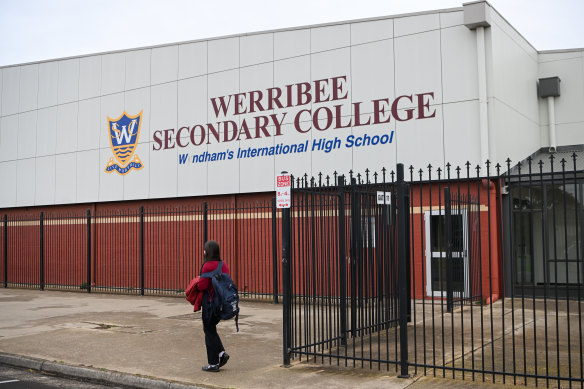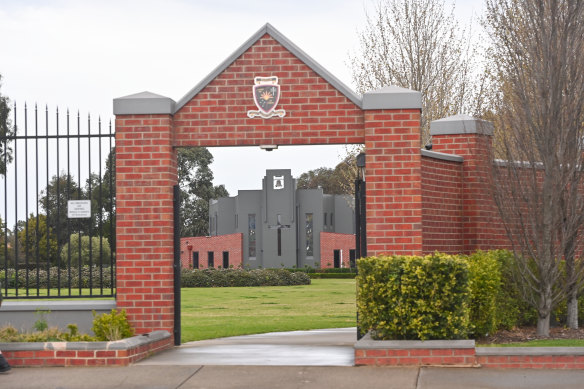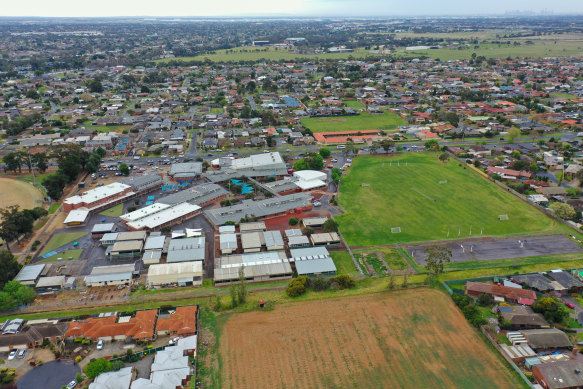By Alex Crowe
Private schools are pocketing thousands of dollars more per student in taxpayer funding than similar public campuses just down the road, according to a new education union report.
Using Australian Curriculum Assessment and Reporting Authority (ACARA) data, the union compared the income per student of Werribee Secondary College and MacKillop Catholic Regional College, located 1.6 kilometres apart in Melbourne’s south-west.
Despite having fewer students with high needs, MacKillop received $1689 more per student in government funding in 2022. Factoring in all income sources, which includes fees, the Catholic school received almost 50 per cent more per student than its neighbour, according to the union.
Two comparable independent schools in the same federal electorate – Al-Taqwa College and the Islamic College of Melbourne – also received significantly more government funding.
The report also compared the income per student of Craigieburn Secondary College, on the northern edge of Melbourne, and Kolbe Catholic College, located a seven-minute drive away.
The schools were similar in size in 2022 but Craigieburn had a larger percentage of high-needs students.

Werribee Secondary College students were reported to have received less government funding in 2022 than the neighbouring Catholic school.Credit: Justin McManus
The report found Kolbe received more than $2300 per student in additional government funding in 2022. Once all sources of income, including fees, were factored in, the advantage was over $6500 per student – a 35 per cent difference.
The report – titled A Decade of Inequality and released on Friday – found 521 Victorian private schools received more combined Commonwealth and state funding than public schools of similar size, socio-economical advantage and location in 2022 – and that the gap was widening.
The union said its report used a strict methodology to ensure only schools of the same type – with very similar student, parental and household characteristics, of similar size and in the same jurisdiction – were compared.
Australian Education Union president Correna Haythorpe said one regional Victorian private school received more than $7000 per student more in government funding than another public school with a “very similar” student profile.

The report found MacKillop Catholic Regional College diverted $6.5 million of income into capital works between 2020 and 2022.Credit: Justin McManus
Nagle College, a private school in Bairnsdale, about 270 kilometres east of Melbourne, picked up combined federal and state funding of $20,305 per student in 2022. In comparison, Springside West Secondary College in Fraser Rise – on the north-west fringe of Melbourne – got $13,023 per student.
“This unfair private school funding advantage translates into a school resourcing and staffing advantage and has fuelled a private school capital works boom, while at the same time denying public schools the recurrent funding needed to attract and retain teachers and to address the high level of student needs in the classroom,” Haythorpe said.
But Independent Schools Australia chief executive officer Graham Catt said independent schools served a broad range of communities with unique needs and the funding reflected that diversity.
Catt said ACARA data showed independent school students received an average of $12,160, while public school students received $22,510 – largely due to state government contributions.

An aerial shot of Werribee Secondary College.Credit: Justin McManus
“It is disappointing to see these repeated and misguided attacks on individual non-government schools, their students, parents and teachers,” he said.
“Rather than fuelling division between sectors, we should be united in ensuring every Australian child receives the best possible education.”
Victorian Catholic Education Authority chief executive officer Elizabeth Labone said the union’s analysis had ignored several factors that impacted funding, including higher allocations for students with disabilities.
Labone said the latest Productivity Commission figures showed non-government schools in Victoria received 40 per cent less in government funding than government schools.
“The Australian Education Union is once again cherry-picking schools to paint a misleading picture of school funding,” she said.
Schools are funded through a combination of Commonwealth, state and territory government funding, and money from fees, charges and other parental or private contributions.
State and territory governments – which manage government schools – provide most of the public recurrent funding for them. The Commonwealth provides the bulk of the public recurrent funding for non-government schools.
Total recurrent government funding for schooling in 2021-22 was $78.69 billion, ACARA data shows. This was made up of $53.5 billion from state and territory budgets and $25.1 billion from the Commonwealth.
Werribee Secondary College principal Amanda Mullins said funding shortfalls meant programs for students falling behind in literacy and numeracy were at risk.
“The main challenges continue to be staffing and being able to run our programs with enough funding for the students with the most need,” she said.
States and territories are locked in negotiations with the federal government to ensure public schools reach 100 per cent of the Schooling Resourcing Standard (SRS) agreed under the Gonski reforms a decade ago.
But a Coalition-era watering down of the agreements mean the states have only had to show they are on a path to eventually reaching 95 per cent of the minimum agreed resourcing requirement.
AEU Victorian branch president Meredith Peace said the data demonstrated the urgency for full SRS funding for all public schools.
“Anything less will fail Victoria’s public schools and their students,” she said.
Start the day with a summary of the day’s most important and interesting stories, analysis and insights. Sign up for our Morning Edition newsletter.